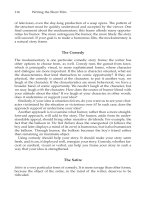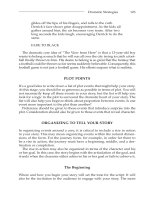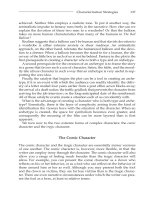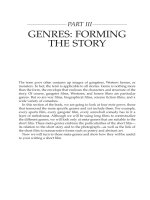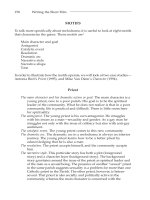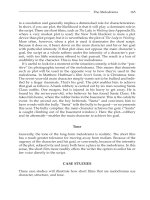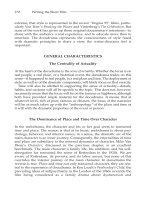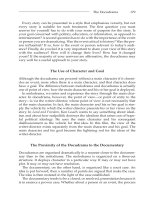Tài liệu Writing the short film 3th - Part 25 docx
Bạn đang xem bản rút gọn của tài liệu. Xem và tải ngay bản đầy đủ của tài liệu tại đây (132.15 KB, 7 trang )
MOTIFS
To talk more specifically about melodrama, it is useful to look at eight motifs
that characterize the genre. Those motifs are
1
Main character and goal
Antagonist
Catalytic event
Resolution
Dramatic arc
Narrative style
Narrative shape
Tone
In order to illustrate how the motifs operate, we will look at two case studies—
Antonia Bird’s Priest (1995), and Mike Van Diem’s Character (1994).
Priest
The main character and his dramatic action or goal. The main character is a
young priest, new to a poor parish. His goal is to be the spiritual
leader of the community. What he does not realize is that in a poor
community, life is practical and difficult. There is little room here
for spirituality.
The antagonist. The young priest is his own antagonist. He struggles
with his issues as a man—sexuality and gender. As a gay man he
struggles not only with the issue of celibacy but also with anti-gay
sentiment.
The catalytic event. The young priest comes to this new community.
The dramatic arc. The dramatic arc in a melodrama is always an interior
journey. The young priest learns how to be a better priest by
acknowledging that he is also a man.
The resolution. The priest accepts himself, and the community accepts
him.
The narrative style. This particular story has both a plot (foreground
story) and a character layer (background story). The background
story gravitates around the issue of the priest as spiritual leader and
of the man as a sexual being. The presence of another “sexual” priest
in the same parish suggests sexuality is a problem for more than one
Catholic priest in the Parish. The other priest, however, is hetero-
sexual. That priest is also socially and politically active in the
community, whereas the main character is concerned with the
158 Writing the Short Film
Ch13.qxd 9/27/04 6:10 PM Page 158
spiritual—as opposed to the everyday—life of his parishioners.
Therein, he differs from the other priest again. The plot relates to the
incest revealed to the main character in the confessional. What is his
responsibility to the young girl and to her family? In the end he acts
on behalf of the girl, against her father.
The narrative shape. The factor of time is not inherently critical in the
melodrama.
The tone. The tone is realistic, as expected in the melodrama.
To offer a final comment on Priest, the priest on first appearance is a power-
ful figure in the community. By making him a gay priest, the screenwriter
makes him one of the powerless minority who struggle for power in society.
Making him sexually active also presents him as a character in the minority
in the power structure of the Catholic Church.
Character
The main character and his dramatic action or goal. This story, set in 1920s
Rotterdam, Holland, is a coming-of-age story of a young man. His
goal is to survive an upbringing of deprivation and suffering.
The antagonist. The antagonist of the story is the biological father, a man
who never acknowledges the main character. When the young man
needs his help, he offers it only under very punitive conditions.
The catalytic event. The catalytic event is the rape of a maid (the main
character’s mother). When she discovers she is pregnant, she
leaves the employ of the rapist, the main character’s birth father.
The dramatic arc. The journey of this main character is very challenging.
Both parents are cold emotionally, and his father is cruel as well.
His journey is one of survival. He does survive his upbringing, but
he pays a very high personal price.
The narrative style. The background story is dominated by the main
character’s relationships with his parents. Fortunately, the plot
enables him to overcome the negative qualities of his parents. The
plot is about self-improvement and education. Initially he teaches
himself English. Later he trains to become a lawyer. Although the
path to self-improvement means reliance on his father for money,
the main character does manage to become a lawyer. At this point
he tells his father that they will never see each other again. He no
longer needs him. The father claims to have made the main charac-
ter the success he is. This idea enrages the main character, but we
in the audience have to wonder whether the father’s claim has
merit.
The Melodrama 159
Ch13.qxd 9/27/04 6:10 PM Page 159
The narrative shape. Mike Van Diem chooses to frame his story with a
murder (of the father) and an interrogation of the son. The story is
then narrated by the son. The story covers the preceding 30 years.
The tone. The tone of the story is realistic, in keeping with the genre.
A note on Character: by choosing a murder story-frame, Van Diem catapults
us into the story. The strategy energizes what would otherwise have fol-
lowed a slower chronological structure.
WRITING DEVICES
There are a number of requisite mechanics that will enable you to shape your
story as a melodrama. The analogy here is to a car or to a building. Both have
to be functional; both can be creative. But without those mechanics in place,
neither will be either functional or creative. So it is with your story—and so
we turn to those writing devices that are the mechanics of the melodrama.
Your Character Should Have an Objective
A character without a goal, a passive character, is rudderless, subject to the
goals of others and to the plot. Although a melodrama can work with a pas-
sive character (Steven Soderbergh’s Sex, Lies, and Videotape and Gus Van
Sant’s My Own Private Idaho are examples), for the most part melodramas
work best when the main character is active and goal-directed.
What is an adequate goal for a character in a melodrama? A somewhat
negative example will illustrate the need for a purposeful goal. The main
character in Peter Weir’s The Truman Show wants to escape his life as an on-
air telecast. The problem here is that the character realizes this goal only after
a third of the story has elapsed; once he articulates that goal, he spends the
balance of the story achieving it. Once the conceit of his world—his life is a
24-hour-a-day television show, complete with the artifice of a set and cast
that pretends to be his town, his house, and his wife—is unmasked, there are
no more barriers of understanding for the character to achieve. Only the act
of achieving freedom will do. We watch him achieve his freedom, as earlier
we watched the artifice of his life. The problem here is that the goal, once
acknowledged, is too flat in its struggle with the plot (his life as television).
His is not a journey toward understanding, but rather, having understood
the true nature of his life, he wants to escape that life.
This main character has a goal, but the goal results in too flat a story. Either
the goal or the plot has to give amplitude to the story. What we find is help-
ful in giving amplitude to a story is the mechanical device of triangulation.
160 Writing the Short Film
Ch13.qxd 9/27/04 6:10 PM Page 160
Triangulation
Triangulation is a device whereby the main character explores two opposing rela-
tionships. Those two relationships can be viewed as the two opposing choices.
They can also be viewed as two opposing means for the character to achieve
his or her goal. In either case, the exploration of these two relationships gives
the melodrama amplitude. It prevents the drama from flattening out, as occurs
in Leaving Las Vegas and in The Truman Show described above.
To illustrate how triangulation works, we turn first to a simple structure
(no plot)—the film Truly, Madly, Deeply. A woman has lost her lover. Her goal
is to refuse to accept the loss, to hold onto her grief. The two relationships
that are fully explored in this particular triangulation are the woman’s rela-
tionship with her dead lover (he comes back as a ghost) and her relationship
with a new suitor. The first relationship maintains her goal, and the second
challenges it. In the end she opts for a live lover and a future, and it is the
ghost that in the end says goodbye to her.
It is possible in the melodrama to have more than one triangle, although
one triangle will always take primacy over the others. The presence of more
than one triangle simply complicates the story further. This is especially
important in Sex, Lies, and Videotape, a melodrama where the main character
is passive, without a goal until the last third of the story.
The primary triangle is between the main character, her husband, and the
guest (her husband’s friend Graham). Her husband represents the unfaith-
ful, untruthful, manipulative mate, while Graham is truthful, interested in
her, and not at all manipulative. These two male-mate choices represent the
primary triangle in the story. A secondary triangle is the triangle of the main
character, her husband, and her sister. Both her husband and her sister are
betraying her, and it is the resolution of this triangle that prompts the main
character finally to act: she discovers that the two have been having an affair
and have been so bold as to make love in her bedroom. A third triangle is the
main character, her sister, and the male guest. It is the experience of being
videotaped by him while she talks about sex that prompts the sister to reject
the husband, and eventually prompts the main character to choose (via
videotape) to awaken sexually and to leave her husband for the guest. These
three triangulations form the actual progression, the train tracks of the jour-
ney of the main character.
Use Plot Against the Main Character’s Goal
Just as triangulation provides a method to build the dramatic arc of the story,
plot can be used to make the climb steeper and consequently more gripping.
It should be said again that it is not necessary for a melodrama to have a plot,
The Melodrama 161
Ch13.qxd 9/27/04 6:10 PM Page 161
but if you choose to use plot, it should be used in a particular fashion. In the
melodrama, plot tends to be used against the character and his or her goal.
The flip side to this is the situation comedy, where the plot is used in the
opposite way, to enable the character to achieve his or her goal. Having stated
the ground rule, we should also mention that inventive writers alter those
rules. A case in point is Woody Allen’s Crimes and Misdemeanors. Allen mixes
both melodrama and situation comedy in these tales of two characters—an
ophthalmologist and a documentary filmmaker. The goal of the main char-
acter in the melodrama is to maintain his life situation and status. His mis-
tress threatens to upset the status quo by telling all to his wife. The plot is the
murder of his mistress. In classic melodrama, the plot should lead to the
downfall of the main character. Instead, in this story the plot enables the
character to achieve his goal.
The second plot line about the documentary filmmaker is a situation com-
edy. The character’s goal is to produce ethically worthy documentary films
that will give him the status he feels he deserves. Unhappy in his marriage, the
character is offered the opportunity to produce a TV biography of a
Hollywood TV producer (his wife’s brother). This plot should bring him the
money to make his worthy projects. It also introduces him to a woman he
believes will elevate him out of his unhappy marriage. Again, Allen upsets our
expectations. The plot undermines the filmmaker, dooming him to failure on
all fronts. Indeed, even his ethical goal of a worthy production is thwarted, by
the death of his subject by suicide.
Woody Allen’s film is unusual; typically, genre expectations are met as
described earlier in this chapter. Plot should work against the main charac-
ter and his goal. Two additional examples will illustrate how this works.
Paul Thomas Anderson’s Boogie Nights is the story of a man whose goal is to
gain recognition or, in a more modest sense, acknowledgment that he has
value in his family and in his community. The plot that he looks to as the
opportunity for recognition is a career as a star in pornographic movies.
Although initially his star rises, and his career could be deemed a success, he
quickly falls, and the plot becomes the means to his devaluation. In the end
he is a victim of the plot.
The tension between the character’s goal and the plot can be as important
as the triangulation in making the melodrama dramatically viable.
Resolution or No Resolution
Generally, melodramas resolve when the main character either achieves his
or her goal or fails to do so. For the majority of melodramas, the issue of res-
olution has been the end point of the story. However, a number of story-
tellers have begun to opt for no resolution—or to put it another way, for an
162 Writing the Short Film
Ch13.qxd 9/27/04 6:10 PM Page 162
